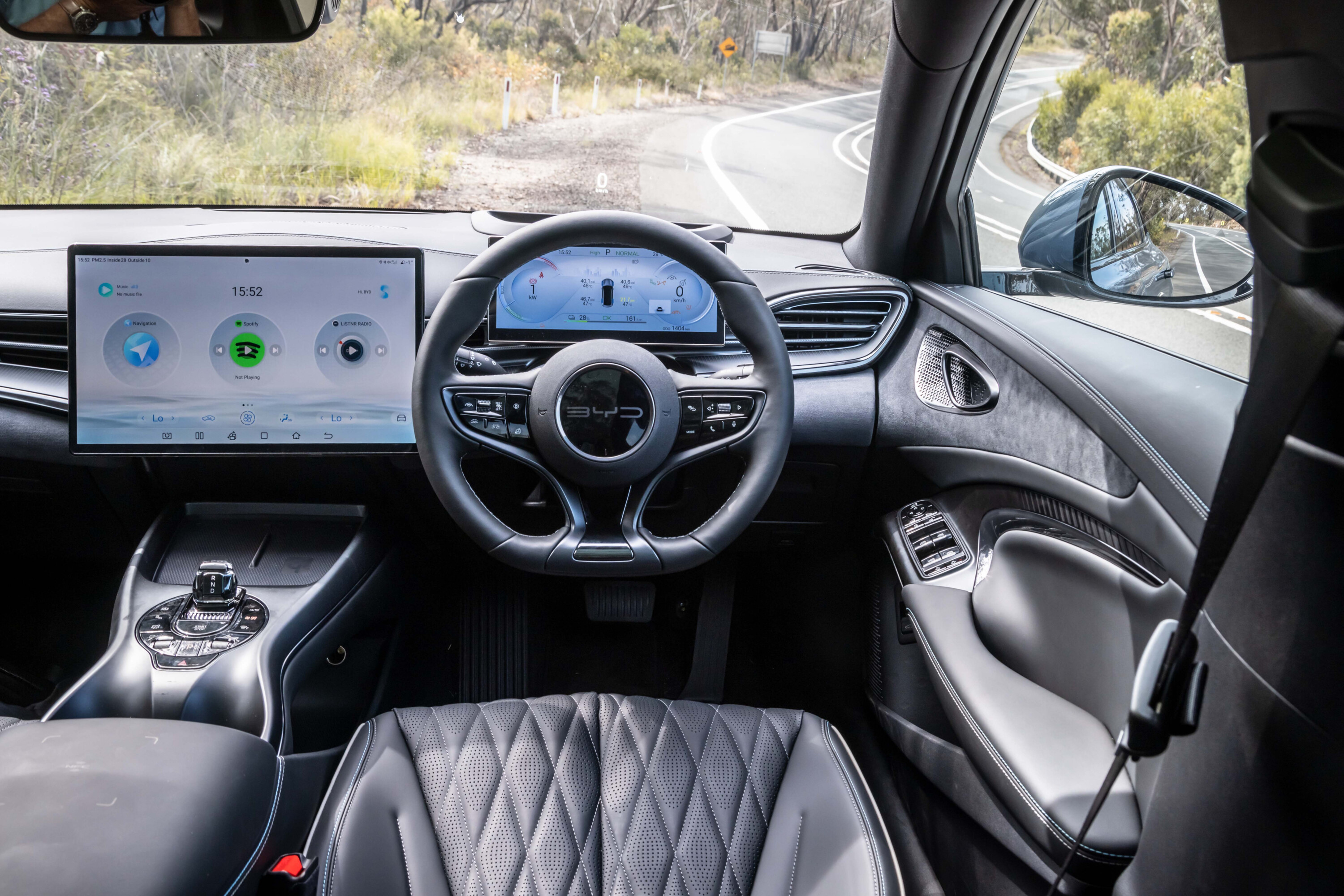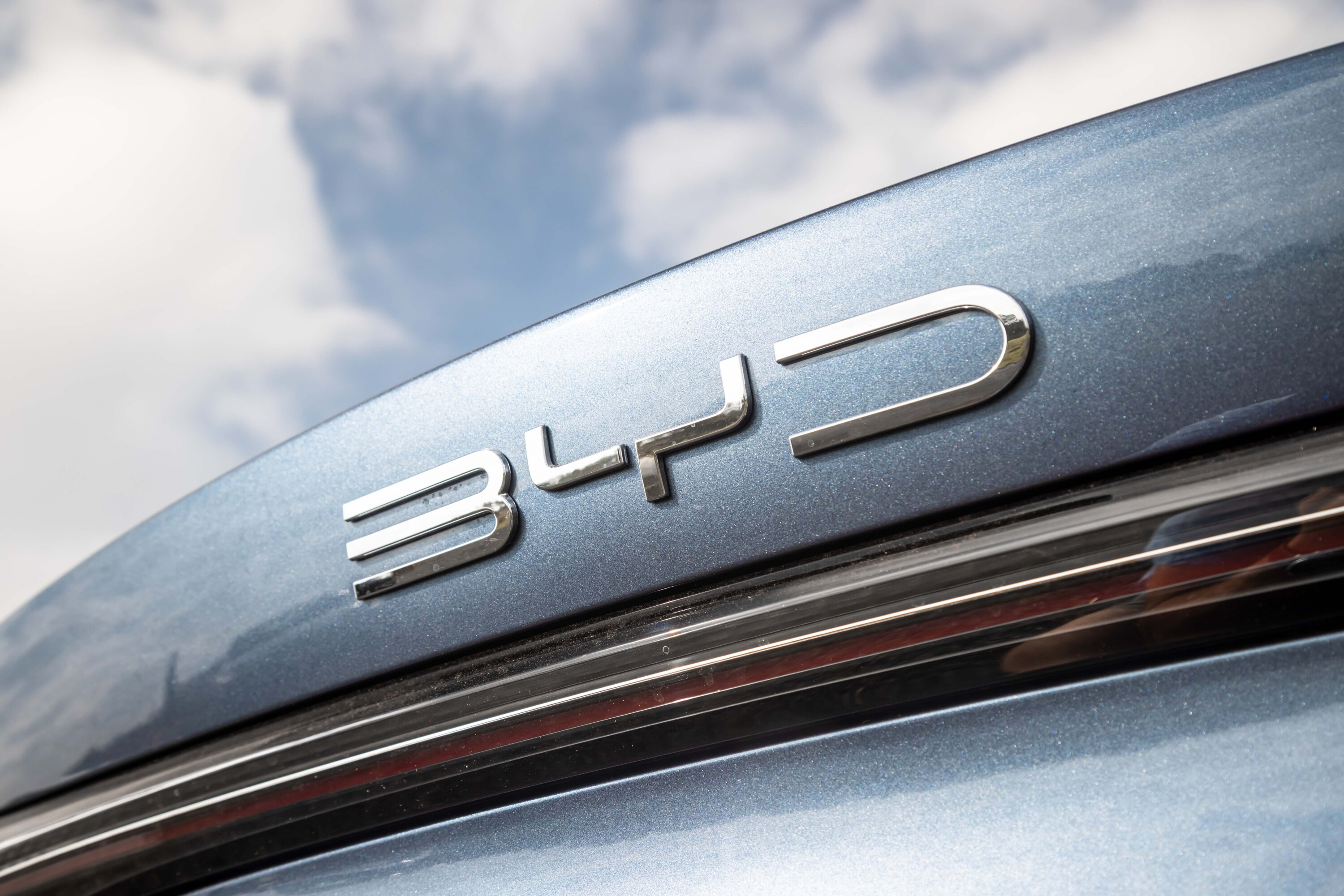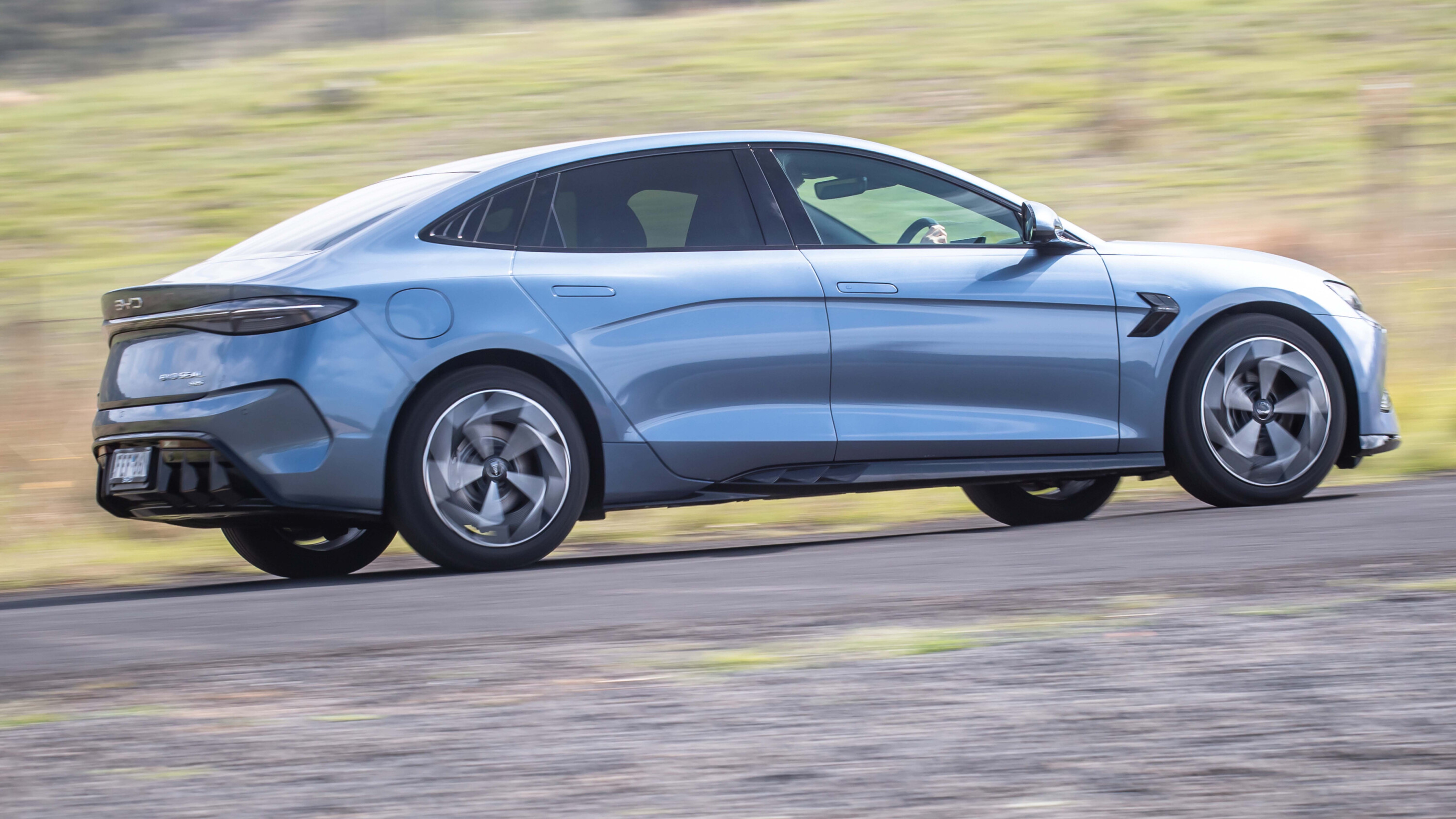
Score breakdown
Things we like
- Loaded for the money
- More usable controls than some rivals
- Frightfully fast
Not so much
- Spooky handling
- Easily agitated ride
- Poor brake response and limited regen effect
- Occasionally violent lane-change assist
Talk about a headline act. The BYD Seal Performance is a four-door electric sedan that reshapes the bang-for-buck equation in Australia.
Never before has a manufacturer offered so many kilowatts for such little money – 390kW for $68,748. Paired with an eye-watering 0-100km/h time of just 3.8 seconds in flagship form, a lengthy list of equipment and great levels of space, the Seal looks like a stunning deal.
So, is there a catch?

JUMP AHEAD
Pricing and features
It’s the “KiloWatts-for-the-Kash King” in the Australian market. You’re paying $176.27 per kW of power here, which makes this a better bang-for-buck option than anything else on the market. It’s even more compelling than the MG4 X Power in that metric ($187.46/kW).
Beyond that you’re also getting an immense equipment list including 19-inch alloy wheels; LED headlights, daytime running lights and tail-lights; a panoramic glass roof; a 15.4-inch rotating touchscreen infotainment system with wireless Android Auto and wired Apple CarPlay, satellite navigation and DAB digital radio; a Dynaudio 12-speaker sound system; twin wireless phone chargers; a 10.25-inch digital instrument cluster; quilted leatherette-upholstered power-adjustable front seats with heating and ventilation; keyless entry and start… And that’s just the start.
It also has the liveable (conventional) features you might appreciate if you’re cross-shopping it against a Tesla Model 3, including a physical gear selector and blinker/wiper stalks, plus a key fob (like the Tesla, there’s also an NFC card to unlock and start the car, or you can use the BYD app).

It is easy to see why you’d think the Seal could be a brilliant choice: huge power, heaps of gear, and it’s got the battery technology, too.
The Performance grade has a 82.5kWh ‘Blade’ LFP battery pack allowing it a WLTP-rated driving range of 520km, and there’s a pair of motors to employ all-wheel drive in this top-spec version.
BYD also includes a home charging cable, the Seal is vehicle-to-load (V2L) capable, and this grade has a few features you don’t get in the more affordable Dynamic ($49,888) and Premium ($58,798 both before on-road costs), such as a heated steering wheel, and frequency-selective dampers.

There’s AC charging at a maximum rate of 7kW, and DC charging tops out at 150kW.
Plugged into a typical single-phase wall box, the BYD will take 11 hours and 45 minutes to charge from flat to 100 per cent. When fast-charging at public stations over 150kW, the Seal will take 37 minutes to climb from 10-80 per cent .
For context, a Model 3 Performance offers 11kW AC/270kW DC charging capability, while the Hyundai Ioniq 6 can manage 22kW AC (optional) and 350kW DC, getting it from 10-80 per cent in 18 minutes.
The efficiency rating for the all-wheel-drive Performance is impressive, at 15.9kWh/100km (WLTP). Over this test, we averaged 20.3kWh/100km, with a mix of real-world and enthusiastic driving included. That equates to a real-world 406km driving range from a full charge.
You’ll want to study the warranty paperwork if you’re considering a BYD, as in Australia the business takes the unusual step of varying the length of cover depending on component.
There’s a six-year/150,000km warranty plan for the car and a battery warranty of eight years/160,000km, yet the infotainment system, wheel bearings and other items are only covered for three years/60,000km, while lights, suspension ball joints and tyre pressure monitoring are guaranteed for four years/100,000km.

The Seal has an eight-year capped-price servicing plan with intervals of 12 months/20,000km, and it costs an average of $299 per visit over that period.
The cabin has some wow-factor, with the 15.4-inch rotating mega-screen and interesting trim finishes (that are nicer than the Atto 3’s), as well as smartphone mirroring tech and seemingly dozens of menus upon menus.
It can be tricky to find your way around the screen at times, but keep in mind you can jump between screens using the steering wheel controls, too.

The Seal’s cabin space is decent, with enough room for adults to sit three across if need be and ample legroom. But the glass roof does allow heat in on summer days and there’s little toe room.
Amenities include four door pockets, cup holders front and rear, multi-pocket seatbacks, rear directional air vents, and a pair of USB ports for both rows.
The boot space is stated at 400 litres, but there’s also a couple of hidden storage sections under the boot floor for your cables, and a tyre repair kit (which proved to be effective when we suffered a puncture!). The Seal’s under-bonnet frunk adds an extra 50L of stowage space.

Safety
BYD has sealed (ahem) a five-star ANCAP rating against the strictest criteria to date with a 2023 date stamp, so it has all the gear you’d expect. Not all of it is well integrated, though (more of which in the driving section).
Standard is autonomous emergency braking (AEB) with pedestrian, cyclist and junction detection, lane-keeping and emergency lane keep assist, adaptive cruise control, ‘intelligent’ speed sign recognition, driver attention alert, blind-spot monitoring, front- and rear-cross traffic alert with braking, a surround-view camera and parking sensors, and plenty more, including nine airbags.
There are ISOFIX points in the window seats and three top-tethers, too.

On the road
This is a tremendously fast car, with a 0-100km/h time to rival some EVs three to four times its price.
A specific example? Well, the Seal Performance’s 3.8sec claim puts it just a tenth behind a Porsche Taycan GTS that costs more than $250K on the road.
You’ll want to make sure your head is braced against the headrest when you punch the Seal’s throttle, because the acceleration is brain-meltingly quick. The world around you feels like it’s blurring as your mind attempts to keep up with what’s happening.
The entertainment factor just about stops there, unfortunately, as the Seal – at least in this top-of-the-range Performance guise – lacks the handling poise and predictability to give the driver much confidence on country roads.

And while the Continental EcoContact tyres would be fine on a lower-spec model, they don’t provide as much grip as you’d hope when taking a rapid 2.2-tonne, 4.8-metre sedan through tight and twisty bends.
With limited regen braking on offer, the actual brakes are needed more than they would be in most rival EVs and inconsistent pedal response makes it trickier to modulate braking effort.
The regenerative braking doesn’t have a single-pedal driving mode, and while it is adaptable with Comfort or Sport modes, it still feels somewhat underdone when you’re trying to slow down this much mass from massive speed.
I spent a few days in this car in a mix of different scenarios and, for the most part, the Seal Performance, which wears 19-inch wheels, was fine in urban driving, though the ride isn’t terrifically well judged.
Either jittery or lumpy, depending on the road, the Seal Performance struggles to settle like a Model 3 even on decent-quality bitumen, while it lacks the compliance of a Hyundai Ioniq 6 on bigger, 20-inch wheels.
We’ll need to wait to drive a base or mid-spec Seal to find out whether the Performance’s exclusive ‘frequency-selective’ dampers are part of the issue.

Some of Seal’s active safety systems are great, such as the front- and rear-cross traffic alert with braking assistance, which can essentially help you see beyond parked cars if you’re pulling out of a driveway, and the excellent surround-view camera system which makes piloting this car into a parking spot very easy indeed.
But other elements of the safety suite are horrible. The unnervingly jerky emergency lane-keeping system is one of the most violent we’ve experienced, and the speed-sign recognition system’s insistent binging and bonging is unendingly annoying.
You can turn them off every time you restart the car if you wish (about 20 seconds, give or take!).
If any of the terms in this section have left you scratching your head, these articles will help bring you up to speed!

- What is a Powertrain or Drivetrain?
- Power vs torque
- Car suspension explained
- Automatic transmissions (‘gearboxes’) explained
- Chassis control systems explained
- Car vs Ute vs SUV: How the vehicle you buy should guide the way you drive
- What is the WLTP emissions and range test?
The Model 3, as the best-selling electric sedan, is the most obvious competitor – and undoubtedly BYD’s primary target.
But there’s no shortage of other options in the electric sedan segment, including AWD dual-motor variants offering plenty of speed.
The Polestar 2, priced from $67,400 in RWD form, is even available with a Performance Pack to bring greater dynamic focus.
Or there’s Hyundai’s Ioniq 6, which costs from $65,500 in RWD form though from $81K if you want AWD.

Should I put it on my shortlist?
The Seal Performance goes like the proverbial off a shovel, comes with a heck of a lot of gear, looks interesting, has a roomy interior, and has a lengthy driving range.
You can tick many of those boxes, however, with the cheaper Dynamic and Premium variants – and, if your heart is set on a Seal, we’d recommend trying those models.
Until we’ve done the same, we’ll reserve overall judgement on the BYD Seal. For now, the Performance falls well short of rivals in all but bang for your buck.

| 2023 BYD Seal Performance specifications | |
|---|---|
| Powertrain | LFP battery, twin electric motors, single-speed transmission, AWD |
| Max power | 390kW |
| Max torque | 670Nm |
| Drivetrain | all-wheel drive |
| Energy consumption | 16.4kWh/100km (WLTP combined) |
| Price | from $68,748 plus on-roads |
Score breakdown
Things we like
- Loaded for the money
- More usable controls than some rivals
- Frightfully fast
Not so much
- Spooky handling
- Easily agitated ride
- Poor brake response and limited regen effect
- Occasionally violent lane-change assist
We recommend
-
 News
News2024 BYD Seal pricing and features: Watch out, Model 3!
Tesla Model 3 rival lands in Australia with razor-sharp price
-
 Reviews
Reviews2024 BYD Seal review
The next car in the Build Your Dreams empire is the sporty Seal sedan with the Tesla Model 3 firmly in its sights
-
 Comparisons
Comparisons2023 Tesla Model 3 vs BYD Seal: SPEC BATTLE!
BYD has given Tesla a bloody nose, undercutting the Model 3 by $12,000 with its new Seal sedan. But is the BYD actually the smarter buy? Let’s find out…



